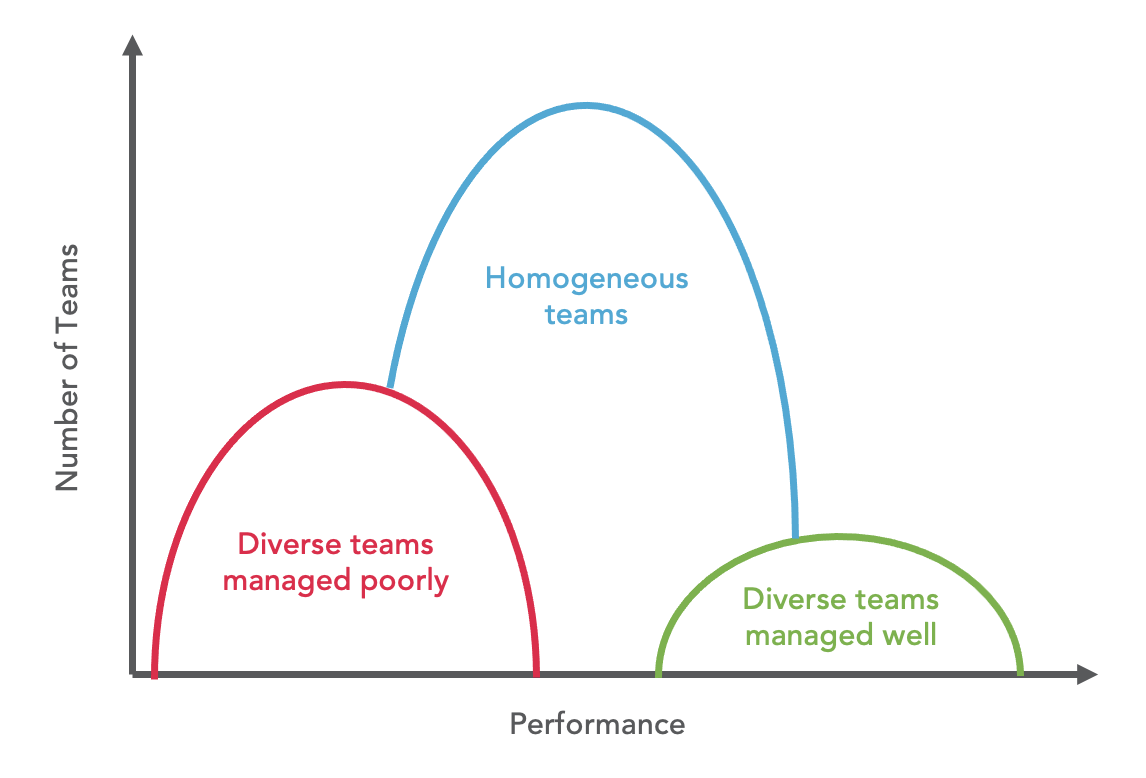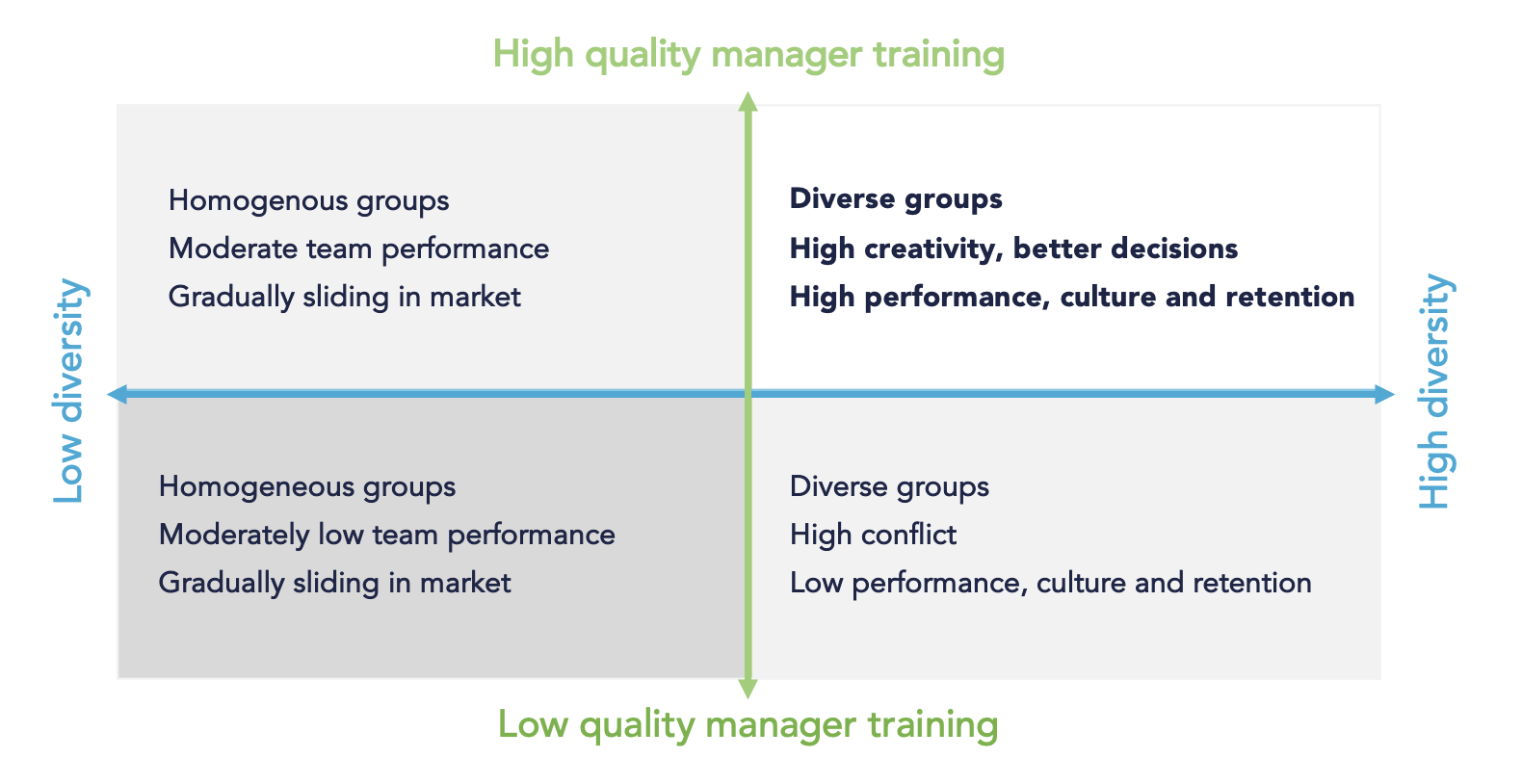The hidden risk of diversity training, and what you should do about it.
by Laurel Newman
There’s little question that DEI initiatives including diversity training have picked up momentum in the past few years. Many companies have increased their commitment to hiring a more diverse work force, to equal pay and equitable treatment, and to increasing diversity in executive roles. There’s good reason for this. In addition to the obvious moral and social justice benefits to diversifying your workforce, there can also be major financial benefits. A 2015 report by McKinsey revealed that companies with greater racial and ethnic diversity performed 35% better than companies with average levels of diversity. A 2018 follow-up study showed that companies with more women in leadership positions outperformed other companies by 21% and were 27% more likely to have superior value creation.
There are several reasons why diversity leads to better business outcomes. A primary reason is that more diverse teams are better able to empathize with diverse needs of customers, which makes them more broadly innovative in responding proactively to customer needs. Another reason is that greater diversity among leaders often results in better decision making. Greater commitment to DEI also gives companies a hiring and retention edge: In one poll, 67% of workers reported that DEI concerns are important to them when they consider taking a job. These numbers are much higher for women and people of color, and this matters for companies because the American work force is increasingly multi-cultural and gender diverse (e.g., 72% of the baby boomer generation is white, while only 56% of millennials are). Of course the demographics that make up our work force are the same demographics that make up our customer base. So it’s not surprising that more and more customers are choosing to purchase from and invest in companies who walk the walk of equity and social good.
Consistent with these cultural shifts, the 2018 report concluded that there is an important “penalty for opting out:” companies who ranked in the bottom quartile on diversity markers were 29% less likely to achieve above average profitability. In other words, simply sticking your head in the sand will not allow you to continue at your current rate of success, but rather will chip away at your corporate foundation as time goes on. Doing nothing is akin to dropping the ball, and you can’t say no one warned you.
So step 1 is getting the right people in the right seats. This means improving your recruiting and hiring practices to attract people with different ethnicities, backgrounds, perspectives, and ways of approaching problems. This also means taking a hard look at your current work force to ensure equity in pay and in top leadership positions.
But research finds that simply bringing a diverse collection of individuals through the door is not enough. In real organizational environments, diverse teams both over-perform and under-perform compared to more homogenous teams:

Source: Distefano, J. J., & Maznevski, M. L. (2000). Creating value with diverse teams in global management. Organizational Dynamics, 29(1), 45–63
The differentiating factor comes down to how well the teams are managed. Diversity leads to better outcomes precisely because the individuals on the team bring with them a greater variety of ideas, perspectives, and values. When not managed well, this variety can increase opportunities for conflict, competitiveness, and mistrust, resulting in poorer performance than you’d get with homogenous teams. When managed well, however, this variety is a valuable asset, increasing the number and innovativeness of ideas, improving the quality of group decisions, and giving team members a deeper sense of belonging and purpose.

This is an important message for team leaders: Adding diversity increases the potential for success as well as the potential for failure. Which one you end up with depends on how well leaders both model and manage the team’s workflow, decision making strategies, and style of interaction. Companies who simply hire a diverse workforce and let them go may be unknowingly setting themselves up for a chaotic culture, poor retention, and poor company performance. To reap the full benefit of their DEI initiatives both in terms of culture and company performance, leaders must invest in diversity training that guides leaders and managers as they adjust to the needs of a more complex workforce.
What can managers to do foster a culture of inclusivity? According to Matt Whiat, who co-leads the diversity training program at Chapman Leadership Institute, “When asked ‘what did the leader do to make you feel included’ employees around the world respond in the same way across cultures, generations, genders, race and any other demographic you can cite:
- They listened (period)
- They asked my opinion
- They recognized me for my contributions
- They provided feedback for me to get better
- They advocated on behalf of me “
 Laurel Newman, is a behavioral scientist who specializes in creating interventions that help companies to improve the experiences and change the behaviors of their customers and employees. Her experience as a Psychology Professor turned Organizational Applied Behavioral Scientist provides her unique insight into the variety of forces that impact people’s thoughts, feelings, and behavior.
Laurel Newman, is a behavioral scientist who specializes in creating interventions that help companies to improve the experiences and change the behaviors of their customers and employees. Her experience as a Psychology Professor turned Organizational Applied Behavioral Scientist provides her unique insight into the variety of forces that impact people’s thoughts, feelings, and behavior.
Whistle is the first learning platform to integrate the key elements that drive business outcomes – ability (microlearning), motivation (micropayments and recognition), cues (AI informed nudges and recommendations) while removing friction (simplified design and mobile centric approach). Together these multiply the impacts of microlearning to maximize the impact on business outcomes.








